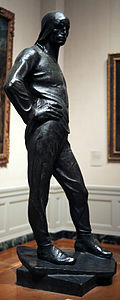Constantin Meunier
This article includes a list of general references, but it lacks sufficient corresponding inline citations. (August 2009) |
Constantin Meunier | |
|---|---|
 Self-portrait, 1885 | |
| Born | 12 April 1831 Etterbeek, Belgium |
| Died | 4 April 1905 (aged 73) Ixelles, Belgium |
| Occupation(s) | Painter, sculptor |
Constantin Meunier (French pronunciation: [kɔ̃stɑ̃tɛ̃ mønje]; 12 April 1831 – 4 April 1905) was a Belgian painter and sculptor. He made an important contribution to the development of modern art by elevating the image of the industrial worker, docker and miner to an icon of modernity. His work is a reflection of the industrial, social and political developments of his day and represents a compassionate and committed view of man and the world.[1]
Early life and education
Constantin Meunier was born in the traditionally working-class area of Etterbeek in Brussels. His family was poor and suffered from the negative economic impact caused by the Belgian Revolution which had taken place the year before Meunier's birth. Meunier's father committed suicide when he was just four years old.[2]

He began studying sculpture at the age of 14 at the
Career

Meunier's first exhibit was a plaster sketch, The Garland, shown at the Brussels Salon in 1851. His first important painting, The Salle St Roch (1857), was followed by a series of paintings including A Trappist Funeral (1860), Trappists Ploughing (1863), in collaboration with Alfred Verwee, Divine Service at the Monastery of La Trappe (1871) and episodes of the German Peasants' War (1878),[5] as well as of Belgium's own historical Peasants' War.
About 1880 Meunier was commissioned to illustrate those parts of Camille Lemonnier's description of Belgium in Le Tour du monde which referred to miners and factory-workers, and produced In the Factory, Smithery at Cockerill's, Melting Steel at the Factory at Seraing (1882), Returning from the Pit, and The Broken Crucible (1884).[5]

In 1882 he was employed by the government to copy
In 1885 he returned to sculpture and produced The Puddler,
The Monument to Labour, which was acquired by the State for the Brussels Gallery, comprises four stone bas-reliefs: Industry, The Mine, Harvest, and the Harbour; four bronze statues: The Sower, The Smith, The Miner, and the Ancestor; and a bronze group, Maternity.[5]
He was one of the co-founders of the Société Libre des Beaux-Arts of Brussels and was a member of the International Society of Sculptors, Painters and Gravers.[6]
Meunier was a
Meunier died in Ixelles on 4 April 1905.[8]
Works
- Paintings
-
Path descending from the slag heap
-
Potato diggers
-
Tobacco Factory, Sevilla
-
Café del Buzero, Sevilla
-
Unloading of a sailboat
-
The Return of the Miners
-
Female miner descending into the pit
-
The organ grinder
- Sculptures
-
The sower
-
The Horse at the Pond 1899
-
Man Battling with the Elements
-
Autumn (Botanical Garden of Brussels)
Museum collections
In 1939, the Musée Constantin-Meunier dedicated to his work was opened in the last house in which Meunier lived and worked, in
See also
- Saemann (Meunier)
References
- ^ Meunier in Leuven Archived 7 December 2021 at the Wayback Machine at M-Museum Leuven
- ^ a b Constantin Meunier, The return from harvest at dusk at Jean Moust
- ^ Ian Mundell, Retrospective reveals the Flemish inspirations of Constantin Meunier Archived 1 January 2021 at the Wayback Machine at Flanders Today
- ^ Pierre Baudson. "Meunier, Constantin." Grove Art Online. Oxford Art Online. Oxford University Press. Web. 6 March 2016
- ^ a b c d e Chisholm 1911.
- Glasgow University. Archived from the originalon 1 July 2013. Retrieved 31 May 2013.
- ^ Berend Bunk, Les trésors du Temple: le Musée belge de la Franc-maçonnerie, Fonds Mercator, 2006, p. 109
- ISBN 9058674886.
- ^ "Constantin Meunier Museum". Belgian Tourist Office (Brussels-Wallonia). Archived from the original on 12 May 2013. Retrieved 9 April 2013.
- ^ Meunier in Leuven at M - Museum Leuven
Sources
- This article incorporates text from a publication now in the public domain: Chisholm, Hugh, ed. (1911). "Meunier, Constantin". Encyclopædia Britannica. Vol. 18 (11th ed.). Cambridge University Press. p. 315.
- P. & V. Berko, "Dictionary of Belgian painters born between 1750 & 1875", Knokke 1981, pp. 466–467.
External links
 Media related to Constantin Meunier at Wikimedia Commons
Media related to Constantin Meunier at Wikimedia Commons- Works by or about Constantin Meunier at the Internet Archive














